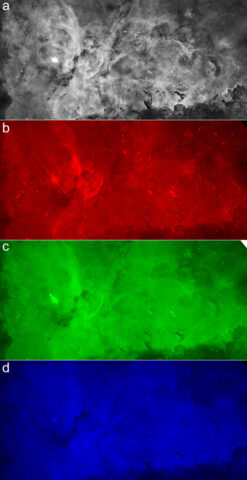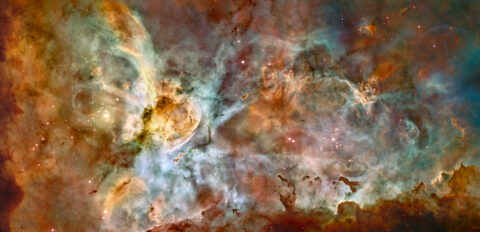The two desktop-sized computer screens in Zolt Levay’s office at the Space Telescope Science Institute in Baltimore, Md., are often ablaze with images of exploding stars, distant galaxies, and ghostly gas clouds. Earlier this year, he was hard at work, putting the finishing touches on a new image (above) of Westerlund 2, a giant Milky Way star cluster, chosen to celebrate Hubble’s 25th anniversary.
For 22 years, ever since corrective optics fixed the Hubble Space Telescope’s blurry vision, Levay has been the observatory’s image maven, assembling color portraits of the heavens that have riveted the public. Gray-haired, soft-spoken, and sporting a prominent mustache, Levay begins his work with the raw black-and-white images, each taken through a different filter, that Hubble transmits to Earth.
Narrow filters allow one specific wavelength—like the red light emitted by hydrogen atoms or the cyan emitted by oxygen atoms—to reach Hubble’s cameras. Broad filters allow a range of wavelengths to pass through, which is more akin to the way the eye perceives color. Many of Hubble’s filters are tuned to colors in the infrared and ultraviolet that the eye cannot see.
Each wavelength or wavelength range is assigned a color: red, green, or blue. In picking the palette for a heavenly scene, “you have to sort of suspend your ideas of what’s natural,” said Levay.
Picking a Palette

Consider, for instance, the light emitted by a gas cloud set aglow by the ionizing radiation from a hot nearby star. The cloud will emit light from hydrogen, oxygen, and sulfur atoms. Both oxygen and sulfur atoms give off a reddish light, but the two emissions come from completely different parts of the gas cloud and highlight completely different structures.
If both the hydrogen and sulfur emissions were portrayed in red, as might seem natural, the image would appear monochromatic, and information about the structure of the gas cloud would be lost. So Levay picks a reddish hue for the emission from hydrogen atoms and chooses green for the light radiated by sulfur, which has a slightly shorter wavelength.
For the new image of Westerlund 2 above, which contains some 3000 stars in a region 6 to 13 light-years across, Levay blended visible and near-infrared light recorded from two of Hubble’s cameras. What results relays important information: Red dots are tiny, faint stars, only 1–2 million years old—so young they have not yet ignited the nuclear furnace at their core. Bright blue stars are mostly foreground stars, not members of the cluster. Shock waves generated when winds from the bright stars slam into dense walls of gas may hasten the birth of new stars, scientists speculate.
In creating any final image, Levay and his assistant, Lisa Frattare, walk a fine line between making the images pleasing to the public and scientifically accurate. In terms of true color, the final image is not what the eye would see. However, the picture preserves the information on structure and composition recorded by Hubble. “These are not scientific images,” Levay explained. “Yet we do want them to be scientifically valid.”
He must also contend with the huge range of brightness, from the most luminous stars to the darkest shadows, in each raw image. If too much emphasis is given to the overwhelming brilliance of the brightest stars, “you won’t see any of the faint detail, even though it’s sitting there in the data,” he noted.
Stellar Evolution, in Subtle Coloring
One of Levay’s favorite Hubble images—and one of the most challenging he’s had to assemble—depicts a Milky Way star-forming region known as the Carina Nebula.

Taken in 2007 to commemorate the telescope’s 17th anniversary, the picture shows the life cycle of stars, from birth to death. Newborn clusters of stars are eroding the birthplaces of stars within dusty pillars while the same clusters are also pushing gas together to make new stars. “You see this whole range of stellar evolution displayed in front of you,” Levay said.
Because Hubble imaged the nebula at just one wavelength, the observatory could provide only the sharp detail, not the color. The hues, derived from multiwavelength observations with a ground-based telescope, are more subdued because the instrument on the ground has lower resolution. Levay used ground-based data along with 32 separate pointings of the Hubble observatory to stitch the image together.
For a detailed look at Hubble’s 25 years of breathtaking images and groundbreaking science, read the Eos.org feature story.
—Ron Cowen, Freelance Writer
Citation: Cowen, R. (2015), The art and science of Hubble’s images, Eos, 96, doi:10.1029/2015EO028951. Published on 27 April 2015.
Text © 2015. The authors. CC BY-NC 3.0
Except where otherwise noted, images are subject to copyright. Any reuse without express permission from the copyright owner is prohibited.

